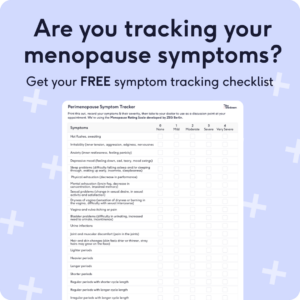Am I perimenopausal? Managing uncertainty in your 30s
What's the lowdown?
Menopause typically happens at age 45-55, with early menopause occurring as young as 40. Perimenopausal symptoms can last 4-8 years [1], meaning it’s possible to be perimenopausal in your 30s.
Approaching menopause at a young age can be scary but tracking your symptoms and empowering yourself with information can help ease the transition into perimenopause.
Primary ovarian insufficiency symptoms are similar to perimenopause, so doctors may investigate this alongside other medical conditions in younger patients.
Compare real-life experiences of perimenopause and HRT reviews here on The Lowdown – and support others by sharing your own!
What are some of the most common symptoms of perimenopause?
Perimenopause is a unique journey for each person, so symptoms and their intensity vary between individuals. Some are lucky to experience just one or two mild symptoms, whereas others will navigate a full spectrum of challenges.
For a full overview, read everything you need to know about perimenopause by Dr Fran.
The earliest sign of perimenopause is often irregular, skipped or stopped periods. If you’ve always had a regular menstrual cycle and begin noticing changes in your 30s, this could signal that your hormones are changing.
Other common symptoms of perimenopause include:
- Hot flushes
- Night sweats
- Vaginal atrophy
- Sleep disturbances
- Low mood or anxiety
- Low sex drive
- Brain fog
- Worsening of PMS

Am I too young to be perimenopausal?
No, you’re not too young to be perimenopausal, but it’s important to get the diagnosis right!
Many people express concern and confusion about being too young to be perimenopausal. It’s a topic shrouded in uncertainty, so let’s set the record straight:
- Typical menopause occurs on average between the ages of 45-55
- Early menopause happens between the ages of 40-45 (and occurs in 7-12% of us)
- Primary Ovarian Insufficiency (previously called premature menopause) under the age of 40 can occur in around 1-3% of us
Remember: menopause is just one day, exactly 12 months after your last period. You’re perimenopausal in the time you experience symptoms up to this point and postmenopausal after this point.
There’s limited data to explain why some people reach menopause at a young age. However, research suggests it could be genetic: you’re more likely to experience early menopause if women in your mother’s family also did [5].
Whilst an earlier menopause is natural for some people, others may have symptoms triggered by another medical problem, which is why it’s important to see your doctor and explain your concerns.
Primary ovarian insufficiency symptoms are similar to perimenopause, so doctors will want to investigate this in younger patients as it’s important not to miss. However, doctors will also want to check you over and make sure your symptoms are not related to anything else before attributing it to perimenopause.
What is primary ovarian insufficiency (POI)?
Primary ovarian insufficiency sounds like complicated jargon. Put simply, it means your ovaries have stopped or slowed their hormone production before the age of 40.
Possible causes of POI include:
- Genetic factors or chromosomal differences: you may be born with fewer follicles (immature eggs) in your ovaries – or you may have a problem with your chromosomes that increases the risk of POI, like Turner’s syndrome or Fragile X syndrome.
- Autoimmune conditions: POI can be associated with autoimmune conditions such as thyroid disorders or diabetes. Autoimmune POI is complex but seems to be due to cells or proteins in your own body responding in the wrong way or “attacking” your eggs.
- Surgery, chemotherapy or radiation: ovaries can be removed or damaged which will slow or stop their hormone production.
- Infection: bacteria and viruses like tuberculosis or mumps can also cause damage to your ovary function.
When should you speak to your doctor?
When it comes to perimenopause, we often hear stories of women feeling dismissed by their doctor or leaving their appointment unsatisfied. Please, don’t let this deter you – if your symptoms are impacting your quality of life, it’s time to seek support.
The Lowdown’s resident menopause specialist, Dr Nikki, advises anyone feeling uncertain about perimenopause in their 30s to start tracking their symptoms, as well as their period dates.
“After 3 months of tracking, book an appointment with a doctor who understands women’s health. Show the information and ask what investigations can be done to look into the symptoms.”
By tracking your symptoms before you see a doctor, you’ll be prepared to answer their questions and get the very most out of your appointment.
For more tips, check out our blog on preparing for your first perimenopause appointment.
What do doctors look out for?
During your appointment, your doctor will question you about your symptoms: when they began, which are the most distressing to you, and how they’re impacting your life.
Dr Nikki shares her approach:
“When someone presents with perimenopause symptoms in their 30s, I always take this seriously. I listen and try to get to the key symptoms that are causing the most distress – and then plan what to do next with investigations and treatment.”
Dr Nikki also recommends reading books on perimenopause to gain an understanding of what’s normal and what treatment options are available. This will help you feel empowered with information during your appointment.
FSH testing
Doctors use FSH testing to confirm early menopause or POI because your FSH (follicle-stimulating hormone) levels rise after this point [7]. During perimenopause, your FSH levels fluctuate. This means FSH testing is not a reliable way to confirm perimenopause – it’s often diagnosed based on symptoms alone.
There’s a slight exception here… for people under 45, doctors may conduct FSH testing to support their perimenopause diagnosis [8]. In this case, two tests taken 6 weeks apart both need to show raised FSH levels for someone to be classed as having early menopause between 40-45 years old, or POI if you’re under 40.
Can you use HRT for perimenopause?
Hormone replacement therapy (HRT) can be used to manage perimenopause symptoms.
HRT works by introducing oestrogen and progesterone to stabilise your natural hormone levels. Keeping oestrogen levels stable helps improve perimenopause symptoms, whilst progesterone protects your uterus from the effects of too much oestrogen.
Your doctor will review your medical history, symptoms, and preferences to ensure you’re a good candidate for HRT. The good news is, that with regular checkups and the right support, HRT can offer a long-term solution for managing perimenopause symptoms in your 30s and beyond.
For an in-depth explanation, check out our blog on perimenopause and HRT. You can also compare real reviews from women who’ve tried it on our HRT review page.
Hormonal contraception such as the pill or the hormonal IUS can also be used to manage perimenopause symptoms. Similar to HRT, you’ll need to discuss your options with your doctor to find the right solution.
What to do if you’re feeling dismissed or frustrated with your care?
Approaching menopause at a young age can be scary. That’s why it’s so important you get the information and support you deserve.
If you’re feeling dismissed or frustrated with your care, here are a few things you can do:
- Specialist Support: request a doctor with specific knowledge of women’s health and/or menopause. Alternatively, book an appointment with one of The Lowdown’s women’s health doctors or Stella’s menopause clinicians.
- Research: empower yourself with information to feel confident asking questions at your next appointment. Get started with our perimenopause blogs and perimenopause product reviews.
- Track: build a detailed picture of your symptoms to track changes and make informed decisions on your care.
- Compare: check out our perimenopause reviews and HRT reviews. Compare experiences of symptoms and treatment, and help others by sharing your own.
Our medical review process
This article has been medically reviewed for factual and up to date information by a Lowdown doctor.

